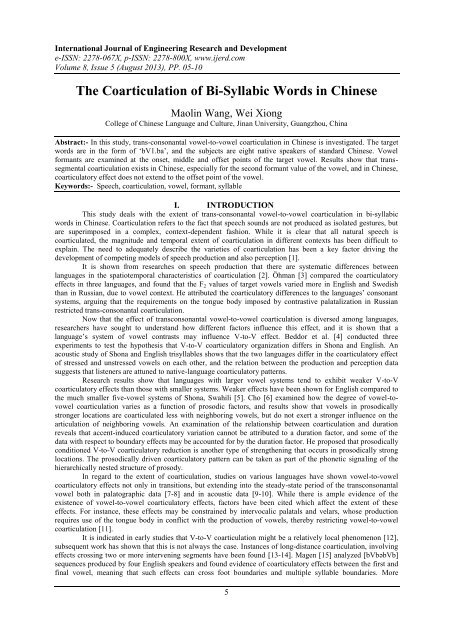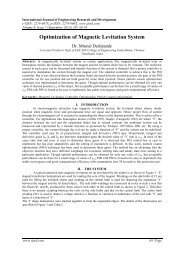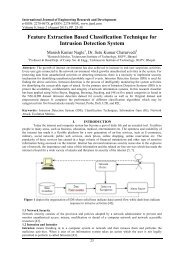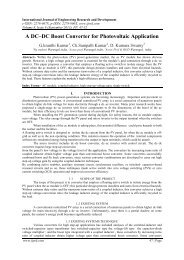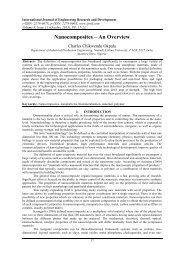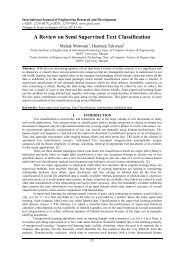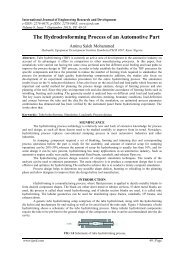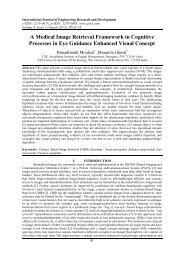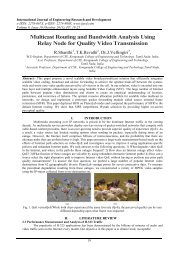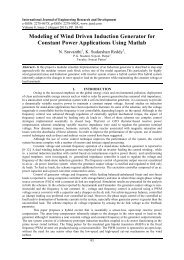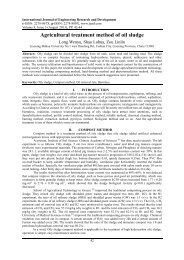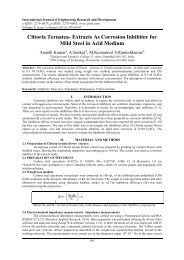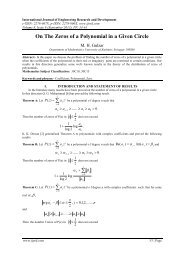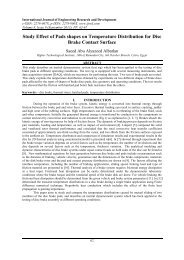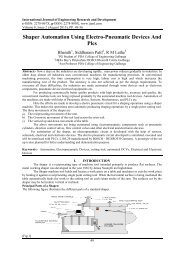The Coarticulation of Bi-Syllabic Words in Chinese
Create successful ePaper yourself
Turn your PDF publications into a flip-book with our unique Google optimized e-Paper software.
International Journal <strong>of</strong> Eng<strong>in</strong>eer<strong>in</strong>g Research and Development<br />
e-ISSN: 2278-067X, p-ISSN: 2278-800X, www.ijerd.com<br />
Volume 8, Issue 5 (August 2013), PP. 05-10<br />
<strong>The</strong> <strong>Coarticulation</strong> <strong>of</strong> <strong>Bi</strong>-<strong>Syllabic</strong> <strong>Words</strong> <strong>in</strong> Ch<strong>in</strong>ese<br />
Maol<strong>in</strong> Wang, Wei Xiong<br />
College <strong>of</strong> Ch<strong>in</strong>ese Language and Culture, J<strong>in</strong>an University, Guangzhou, Ch<strong>in</strong>a<br />
Abstract:- In this study, trans-consonantal vowel-to-vowel coarticulation <strong>in</strong> Ch<strong>in</strong>ese is <strong>in</strong>vestigated. <strong>The</strong> target<br />
words are <strong>in</strong> the form <strong>of</strong> „bV1.ba‟, and the subjects are eight native speakers <strong>of</strong> standard Ch<strong>in</strong>ese. Vowel<br />
formants are exam<strong>in</strong>ed at the onset, middle and <strong>of</strong>fset po<strong>in</strong>ts <strong>of</strong> the target vowel. Results show that transsegmental<br />
coarticulation exists <strong>in</strong> Ch<strong>in</strong>ese, especially for the second formant value <strong>of</strong> the vowel, and <strong>in</strong> Ch<strong>in</strong>ese,<br />
coarticulatory effect does not extend to the <strong>of</strong>fset po<strong>in</strong>t <strong>of</strong> the vowel.<br />
Keywords:- Speech, coarticulation, vowel, formant, syllable<br />
I. INTRODUCTION<br />
This study deals with the extent <strong>of</strong> trans-consonantal vowel-to-vowel coarticulation <strong>in</strong> bi-syllabic<br />
words <strong>in</strong> Ch<strong>in</strong>ese. <strong>Coarticulation</strong> refers to the fact that speech sounds are not produced as isolated gestures, but<br />
are superimposed <strong>in</strong> a complex, context-dependent fashion. While it is clear that all natural speech is<br />
coarticulated, the magnitude and temporal extent <strong>of</strong> coarticulation <strong>in</strong> different contexts has been difficult to<br />
expla<strong>in</strong>. <strong>The</strong> need to adequately describe the varieties <strong>of</strong> coarticulation has been a key factor driv<strong>in</strong>g the<br />
development <strong>of</strong> compet<strong>in</strong>g models <strong>of</strong> speech production and also perception [1].<br />
It is shown from researches on speech production that there are systematic differences between<br />
languages <strong>in</strong> the spatiotemporal characteristics <strong>of</strong> coarticulation [2]. Öhman [3] compared the coarticulatory<br />
effects <strong>in</strong> three languages, and found that the F2 values <strong>of</strong> target vowels varied more <strong>in</strong> English and Swedish<br />
than <strong>in</strong> Russian, due to vowel context. He attributed the coarticulatory differences to the languages‟ consonant<br />
systems, argu<strong>in</strong>g that the requirements on the tongue body imposed by contrastive palatalization <strong>in</strong> Russian<br />
restricted trans-consonantal coarticulation.<br />
Now that the effect <strong>of</strong> transconsonantal vowel-to-vowel coarticulation is diversed among languages,<br />
researchers have sought to understand how different factors <strong>in</strong>fluence this effect, and it is shown that a<br />
language‟s system <strong>of</strong> vowel contrasts may <strong>in</strong>fluence V-to-V effect. Beddor et al. [4] conducted three<br />
experiments to test the hypothesis that V-to-V coarticulatory organization differs <strong>in</strong> Shona and English. An<br />
acoustic study <strong>of</strong> Shona and English trisyllables shows that the two languages differ <strong>in</strong> the coarticulatory effect<br />
<strong>of</strong> stressed and unstressed vowels on each other, and the relation between the production and perception data<br />
suggests that listeners are attuned to native-language coarticulatory patterns.<br />
Research results show that languages with larger vowel systems tend to exhibit weaker V-to-V<br />
coarticulatory effects than those with smaller systems. Weaker effects have been shown for English compared to<br />
the much smaller five-vowel systems <strong>of</strong> Shona, Swahili [5]. Cho [6] exam<strong>in</strong>ed how the degree <strong>of</strong> vowel-tovowel<br />
coarticulation varies as a function <strong>of</strong> prosodic factors, and results show that vowels <strong>in</strong> prosodically<br />
stronger locations are coarticulated less with neighbor<strong>in</strong>g vowels, but do not exert a stronger <strong>in</strong>fluence on the<br />
articulation <strong>of</strong> neighbor<strong>in</strong>g vowels. An exam<strong>in</strong>ation <strong>of</strong> the relationship between coarticulation and duration<br />
reveals that accent-<strong>in</strong>duced coarticulatory variation cannot be attributed to a duration factor, and some <strong>of</strong> the<br />
data with respect to boundary effects may be accounted for by the duration factor. He proposed that prosodically<br />
conditioned V-to-V coarticulatory reduction is another type <strong>of</strong> strengthen<strong>in</strong>g that occurs <strong>in</strong> prosodically strong<br />
locations. <strong>The</strong> prosodically driven coarticulatory pattern can be taken as part <strong>of</strong> the phonetic signal<strong>in</strong>g <strong>of</strong> the<br />
hierarchically nested structure <strong>of</strong> prosody.<br />
In regard to the extent <strong>of</strong> coarticulation, studies on various languages have shown vowel-to-vowel<br />
coarticulatory effects not only <strong>in</strong> transitions, but extend<strong>in</strong>g <strong>in</strong>to the steady-state period <strong>of</strong> the transconsonantal<br />
vowel both <strong>in</strong> palatographic data [7-8] and <strong>in</strong> acoustic data [9-10]. While there is ample evidence <strong>of</strong> the<br />
existence <strong>of</strong> vowel-to-vowel coarticulatory effects, factors have been cited which affect the extent <strong>of</strong> these<br />
effects. For <strong>in</strong>stance, these effects may be constra<strong>in</strong>ed by <strong>in</strong>tervocalic palatals and velars, whose production<br />
requires use <strong>of</strong> the tongue body <strong>in</strong> conflict with the production <strong>of</strong> vowels, thereby restrict<strong>in</strong>g vowel-to-vowel<br />
coarticulation [11].<br />
It is <strong>in</strong>dicated <strong>in</strong> early studies that V-to-V coarticulation might be a relatively local phenomenon [12],<br />
subsequent work has shown that this is not always the case. Instances <strong>of</strong> long-distance coarticulation, <strong>in</strong>volv<strong>in</strong>g<br />
effects cross<strong>in</strong>g two or more <strong>in</strong>terven<strong>in</strong>g segments have been found [13-14]. Magen [15] analyzed [bVbəbVb]<br />
sequences produced by four English speakers and found evidence <strong>of</strong> coarticulatory effects between the first and<br />
f<strong>in</strong>al vowel, mean<strong>in</strong>g that such effects can cross foot boundaries and multiple syllable boundaries. More<br />
5
<strong>The</strong> <strong>Coarticulation</strong> <strong>of</strong> <strong>Bi</strong>-<strong>Syllabic</strong> <strong>Words</strong> <strong>in</strong> Ch<strong>in</strong>ese<br />
recently, Grosvald [16] studied long-distance vowel-to-vowel coarticulation <strong>in</strong> English, and found that<br />
anticipatory V-to-V coarticulation can occur over at least three vowels‟ distance <strong>in</strong> natural discourse, and that<br />
even such long-distance effects can be perceived by some listeners.<br />
<strong>The</strong>re has been some research work on the coarticulation <strong>of</strong> segments <strong>in</strong> Ch<strong>in</strong>ese. Wu and Sun [17]<br />
analyzed the acoustic coarticulatory patterns <strong>of</strong> voiceless fricatives. <strong>The</strong> fricatives are designed <strong>in</strong> CVCV<br />
contexts <strong>in</strong> which three peripheral vowels are comb<strong>in</strong>ed with the fricatives <strong>in</strong> C1 and C2. Acoustic data,<br />
<strong>in</strong>clud<strong>in</strong>g frequencies and durations <strong>of</strong> the lower marg<strong>in</strong>s, concentration bars, vowel formants and the onset and<br />
<strong>of</strong>fset transitions, are measured. It is found that there are three types <strong>of</strong> coarticulation effects: homorganic,<br />
heterorganic and contiguous.<br />
Yan [18] studied the vowel formant pattern and the coarticulation effect <strong>in</strong> the voiceless stop onset<br />
monosyllables, and it is found that there is no effect <strong>of</strong> tones on formant values <strong>of</strong> the vowel. However, there is<br />
significant effect <strong>of</strong> aspiration on the formant values at the onset po<strong>in</strong>t <strong>of</strong> the vowel. Chen [19] <strong>in</strong>vestigated the<br />
<strong>in</strong>tersyllabic anticipatory coarticulation <strong>in</strong> CVCV sequences, and found that there is no effect <strong>of</strong> articulation<br />
manner on the formant values. <strong>The</strong>re is coarticulatory effect <strong>of</strong> C2 on V1, as well as V2 on V1. Sun [20] analyzed<br />
the coarticulation effect <strong>of</strong> vowels <strong>in</strong> read speech, and found that, as the speak<strong>in</strong>g rate <strong>in</strong>creases, the deviation <strong>of</strong><br />
the vowel formant is also magnified, as is shown <strong>in</strong> the apparent centralization <strong>of</strong> the vowel. In fast speech, the<br />
fromant values <strong>of</strong> /i/ and /u/ are significantly different, due to the frontness and the backness <strong>of</strong> the follow<strong>in</strong>g<br />
consonants. Besides, there is also the study on the anticipatory coarticulation <strong>in</strong> V1#C2V2 sequences [21], and<br />
coarticulatory effect <strong>in</strong> VCV sequences [22]. However, as far as we know, there have no studies on<br />
coarticulatory effect at different vowel po<strong>in</strong>ts <strong>in</strong> Ch<strong>in</strong>ese.<br />
<strong>The</strong> present study will <strong>in</strong>vestigate the effect <strong>of</strong> trans-segmental coarticulation <strong>in</strong> Ch<strong>in</strong>ese. In particular,<br />
it will try to answer the follow<strong>in</strong>g questions. Does trans-segmental coarticulation occur <strong>in</strong> Ch<strong>in</strong>ese? What is the<br />
extent <strong>of</strong> coarticulation <strong>in</strong> Ch<strong>in</strong>ese? <strong>Coarticulation</strong> may be classified as carry-over (left-to-right) or anticipatory<br />
(right-to-left) ones, and the present study will focus on carry-over coarticulation.<br />
II. METHODOLOGY<br />
A. Speakers and stimuli<br />
<strong>The</strong> speakers for this experiment were eight native speakers <strong>of</strong> Standard Ch<strong>in</strong>ese, four males and four<br />
females. <strong>The</strong> stimulus list is comprised <strong>of</strong> 6 stimuli, embedded <strong>in</strong> three carrier sentences <strong>of</strong> Ch<strong>in</strong>ese, each<br />
conta<strong>in</strong><strong>in</strong>g an item from a set <strong>of</strong> two target words. <strong>The</strong> target words are „<strong>Bi</strong>ba‟ and „Baba‟, which are supposed<br />
to be two persons‟ names. <strong>The</strong>y are <strong>in</strong> the form <strong>of</strong> „bV1.ba‟, with /a/ as the target vowel, and V1 provid<strong>in</strong>g the<br />
„chang<strong>in</strong>g‟ vowel contexts, namely, the contexts <strong>of</strong> /a/ and /i/.<br />
Labial /b/ is chosen to m<strong>in</strong>imize the effects <strong>of</strong> consonant articulation on l<strong>in</strong>gual articulations [3].<br />
With<strong>in</strong> the carrier sentences, the target item is located at the sentence medial position. One example is shown as<br />
follow,<br />
Zhe shi <strong>Bi</strong>ba de jiejie.<br />
This is <strong>Bi</strong>ba‟s sister.<br />
B. Procedure and measurements<br />
<strong>The</strong> speakers were asked to read the sentences three times, <strong>in</strong> random order for each time, <strong>in</strong> normal<br />
speed, so each speaker produced 18 tokens: 6 sentences × 3 repetitions. In total, 144 tokens were acoustically<br />
analyzed (18 tokens × 8 speakers).<br />
This study aims at <strong>in</strong>vestigat<strong>in</strong>g the extent <strong>of</strong> V-to-V coarticulation <strong>in</strong> VCV sequences, and vowel<br />
formants were exam<strong>in</strong>ed. Formant values were extracted us<strong>in</strong>g Praat [23], and the extent <strong>of</strong> trans-consonantal<br />
coarticulation was analyzed by compar<strong>in</strong>g the formant values <strong>of</strong> the target vowel at three po<strong>in</strong>ts: the onset po<strong>in</strong>t,<br />
the middle po<strong>in</strong>t and the <strong>of</strong>fset po<strong>in</strong>t. That is, formant values at the onset, middle and <strong>of</strong>fset po<strong>in</strong>ts <strong>of</strong> the target<br />
vowel /a/ were extracted, and the values at different vowel contexts were compared. As is mentioned <strong>in</strong> the<br />
previous subsection, there are two contexts for the target vowel, /i/ and /a/. Coarticulatory effect exists if there is<br />
significant difference between the formant values <strong>in</strong> the two vowel contexts. On the contrary, there is no<br />
coarticulatory effect if there is no significant difference. A repeated measures ANOVA was performed for the<br />
comparison, and statistic analysis was done <strong>in</strong> SPSS.<br />
Figure 1 displays the waveforms and formant contours <strong>of</strong> the two key words „<strong>Bi</strong>ba‟ (a) and „Baba‟ (b).<br />
In the graphs, the second syllable „ba‟ is the key syllables, and the preced<strong>in</strong>g syllables „bi‟ and „ba‟ provide the<br />
chang<strong>in</strong>g vowel contexts. Formant values are extracted from the onset, middle and <strong>of</strong>fset po<strong>in</strong>ts <strong>of</strong> the second<br />
syllable „ba‟, which correspond to po<strong>in</strong>t A, B and C <strong>in</strong> the graphs. Comparison is made for formant values <strong>of</strong> the<br />
target values <strong>in</strong> the two contexts at each <strong>of</strong> the three po<strong>in</strong>ts. Taken the onset po<strong>in</strong>t, po<strong>in</strong>t A, as an example, s<strong>in</strong>ce<br />
the contexts shown <strong>in</strong> graph (a) and graph (b) are different, if the formant values at po<strong>in</strong>t A <strong>in</strong> the two contexts<br />
are significantly different, it can be concluded that there is an effect <strong>of</strong> coarticualtion at that po<strong>in</strong>t. In this study,<br />
6
<strong>The</strong> <strong>Coarticulation</strong> <strong>of</strong> <strong>Bi</strong>-<strong>Syllabic</strong> <strong>Words</strong> <strong>in</strong> Ch<strong>in</strong>ese<br />
comparison will be made for both F1 and F2 values at each <strong>of</strong> the three po<strong>in</strong>ts, the onset, middle and the <strong>of</strong>fset<br />
po<strong>in</strong>t.<br />
a. <strong>The</strong> graph <strong>of</strong> „<strong>Bi</strong>ba‟<br />
b. <strong>The</strong> graph <strong>of</strong> „Baba‟<br />
Fig. 1: Waveforms and formant contours <strong>of</strong> the key words „<strong>Bi</strong>ba‟ (a) and „Baba‟ (b)<br />
III. RESULT<br />
Figure 2 presents the mean F1 (a and b) and F2 (c and d) values <strong>of</strong> the target vowel /a/ for male (a and c)<br />
and female (b and d) speakers, <strong>in</strong> the contexts <strong>of</strong> /a/ and /i/, measured at the onset, middle and <strong>of</strong>fset po<strong>in</strong>ts. One<br />
<strong>of</strong> the aims <strong>of</strong> this study is to <strong>in</strong>vestigate the extent <strong>of</strong> the coarticulation, so formant is measured at three po<strong>in</strong>ts,<br />
the onset, middle and the <strong>of</strong>fset po<strong>in</strong>ts <strong>of</strong> the target vowel. Analysis is given <strong>in</strong> the follow<strong>in</strong>g subsections.<br />
A. Onset po<strong>in</strong>t<br />
Results from a repeated measures ANOVA show that, when key words occur at sentence medial<br />
position, at the onset po<strong>in</strong>t <strong>of</strong> the target vowel, with data <strong>of</strong> both male and female speakers pooled together, the<br />
effect <strong>of</strong> chang<strong>in</strong>g vowel is significant for F2, but not for F1. F1: F(1, 71) = 0.04, p = 0.847; F2: F(1, 71) = 47.72,<br />
p < 0.001. That is, coarticulatory effect exists for F2, but not for F1.<br />
B. Middle po<strong>in</strong>t<br />
At the middle po<strong>in</strong>t <strong>of</strong> the target vowel, it is shown that, similar to that at the onset po<strong>in</strong>t, the effect <strong>of</strong><br />
chang<strong>in</strong>g vowel is significant for F2, but not for F1. F1: F(1, 71) = 0.39, p = 0.537; F2: F(1, 71) = 7.28, p = 0.009.<br />
Coarticulatory effect exists for F2, but not for F1.<br />
C. Offset po<strong>in</strong>t<br />
Com<strong>in</strong>g to the <strong>of</strong>fset po<strong>in</strong>t <strong>of</strong> the target vowel, it is shown that the effect <strong>of</strong> chang<strong>in</strong>g vowel is not<br />
significant for either F1 or F2, F1: F(1, 71) = 3.82, p = 0.55; F2: F(1, 71) = 0.25, p = 0.621. Coarticulatory effect<br />
does not exist at that po<strong>in</strong>t.<br />
Frequency (Hz)<br />
780<br />
760<br />
740<br />
720<br />
700<br />
680<br />
660<br />
Onset Middle Offset<br />
a. F1 for male speakers<br />
7<br />
/a/<br />
/i/
Frequency (Hz)<br />
Frequency (Hz)<br />
Frequency (Hz)<br />
1000<br />
960<br />
920<br />
880<br />
840<br />
800<br />
1320<br />
1280<br />
1240<br />
1200<br />
1160<br />
1120<br />
1840<br />
1760<br />
1680<br />
1600<br />
1520<br />
<strong>The</strong> <strong>Coarticulation</strong> <strong>of</strong> <strong>Bi</strong>-<strong>Syllabic</strong> <strong>Words</strong> <strong>in</strong> Ch<strong>in</strong>ese<br />
Onset Middle Offset<br />
b. F1 for female speakers<br />
Onset Middle Offset<br />
c. F2 for male speakers<br />
Onset Middle Offset<br />
d. F2 for female speakers<br />
Figure 2: F1 (a and b) and F2 (c and d) values <strong>of</strong> the target vowel /a/ for male (a and c) and female (b<br />
and d) speakers, <strong>in</strong> the contexts <strong>of</strong> /a/ and /i/, measured at the onset, middle and <strong>of</strong>fset po<strong>in</strong>ts<br />
IV. DISCUSSION<br />
From the results reported <strong>in</strong> the previous section it is noted that, trans-segmental coarticulation does<br />
exist <strong>in</strong> Ch<strong>in</strong>ese, especially for the second formant value <strong>of</strong> the vowel. In this experiment, coarticulatory effect<br />
is exam<strong>in</strong>ed at the onset, middle and <strong>of</strong>fset po<strong>in</strong>ts <strong>of</strong> the target vowel respectively, and both the first and the<br />
second formant values are <strong>in</strong>vestigated. It is found that, as far as carry-over coarticulation is concerned,<br />
coarticulatory effect exists for the second formant values at the onset and the middle po<strong>in</strong>ts <strong>of</strong> the vowel. To be<br />
specific, at the onset and the middle po<strong>in</strong>ts <strong>of</strong> the vowel, there are significant differences between the two<br />
chang<strong>in</strong>g vowel contexts for the second formant, but not the first formant.<br />
<strong>The</strong> effect on the first and the second formants are not consistent with each other at the onset and the<br />
middle po<strong>in</strong>t <strong>of</strong> the target vowel, with F2 affected, while F1 unaffected. We speculate that the reason for this is<br />
that the difference between /a/ and /i/ for F2 is larger than that for F1. Accord<strong>in</strong>g to the report <strong>of</strong> Bao [24], the<br />
mean formant values by 8 male speakers are as follow, /a/: F1 = 984 Hz, F2 = 1157 Hz; /i/: F1 = 283 Hz, F2 =<br />
2350 Hz. <strong>The</strong> differences between /a/ and /i/ for F1 and F2 are 701 Hz and 1193 Hz respectively. <strong>The</strong> difference<br />
<strong>of</strong> F2 is much larger than that <strong>of</strong> F1. When the formant difference is large, the force for trigger<strong>in</strong>g the change <strong>of</strong><br />
course <strong>of</strong> formant contour is also large. That is to say, vowel coarticulatory effect is more likely to occur on<br />
cases with great formant difference, therefore, it occurs on F2, not on F1.<br />
When the <strong>of</strong>fset po<strong>in</strong>t <strong>of</strong> the target vowel is <strong>in</strong>vestigated, it is found that coarticulatory effect does not<br />
exist. That is, for either F1 or F2, there is no coarticulatory effect. This result is caused by the „distance effect‟: at<br />
the onset and the middle po<strong>in</strong>ts, the distance from the measured po<strong>in</strong>t to the chang<strong>in</strong>g vowels is close, and the<br />
effect exists; while at the <strong>of</strong>fset po<strong>in</strong>t, the distance gets farther, and the effect disappears.<br />
8<br />
/a/<br />
/i/<br />
/a/<br />
/i/<br />
/a/<br />
/i/
<strong>The</strong> <strong>Coarticulation</strong> <strong>of</strong> <strong>Bi</strong>-<strong>Syllabic</strong> <strong>Words</strong> <strong>in</strong> Ch<strong>in</strong>ese<br />
Magen [15] <strong>in</strong>vestigated the extent <strong>of</strong> vowel-to-vowel coarticulation <strong>in</strong> English trisyllabic utterances,<br />
and it was found that coarticulatory effects can, <strong>in</strong> some <strong>in</strong>stances, extend beyond the bounds that previous<br />
research had assumed; coarticulatory effect can extend from one full vowel, through the medial schwa, and <strong>in</strong>to<br />
the midpo<strong>in</strong>t <strong>of</strong> the next full vowel. He proposed that foot does not def<strong>in</strong>e the doma<strong>in</strong> over which coarticulatory<br />
effects operate. However, <strong>in</strong> the present study, it is found that coarticulatory effect does not extend to the end <strong>of</strong><br />
the vowel. We speculate this is because that Ch<strong>in</strong>ese is <strong>of</strong> different language typology from English.<br />
One <strong>of</strong> the well-known properties <strong>of</strong> language typology is the rhythm unit <strong>of</strong> a language. Languages<br />
have been categorized as mora-timed, such as Japanese, stress-timed, like English and German, and syllabletimed,<br />
such as Ch<strong>in</strong>ese and French [25-26]. English is a stress-timed language, and the unstressed syllables are<br />
quite weak, so it is possible for coarticulatory effect to extend to the third syllable <strong>in</strong> English. Ch<strong>in</strong>ese is a<br />
syllable-timed language, <strong>in</strong> which syllables are rarely as weak as the unstressed ones <strong>in</strong> English. Compared to<br />
English, the degree <strong>of</strong> articulatory constra<strong>in</strong>t (DAC) <strong>in</strong> Ch<strong>in</strong>ese is high. <strong>The</strong>refore, the coarticulatory effect <strong>in</strong><br />
Ch<strong>in</strong>ese is not as great as that <strong>in</strong> English.<br />
V. CONCLUSION<br />
In this study, the vowel-to-vowel coarticulation effect <strong>in</strong> bi-syllabic words <strong>in</strong> Ch<strong>in</strong>ese is analyzed, and<br />
it is found that trans-segmental coarticulation exists <strong>in</strong> Ch<strong>in</strong>ese, especially for the second formant value <strong>of</strong> the<br />
vowel. <strong>Coarticulation</strong> is more likely to occur on F2 because the difference between /a/ and /i/ <strong>of</strong> F2 is larger than<br />
that <strong>of</strong> F1. Because <strong>of</strong> the „distance effect‟, coarticulatory effect exists at the onset and middle po<strong>in</strong>ts, and<br />
disappeared at the <strong>of</strong>fset po<strong>in</strong>t <strong>of</strong> the target vowel. In Ch<strong>in</strong>ese, coarticulatory effect is not as great as that <strong>in</strong><br />
English, as the two languages are <strong>of</strong> different prosodic typology.<br />
This study is significant for speech eng<strong>in</strong>eer<strong>in</strong>g. In speech synthesis, the effect <strong>of</strong> trans-segmental<br />
coarticulation must be taken <strong>in</strong>to consideration, especially for the second formant value <strong>of</strong> the vowel. <strong>The</strong> first<br />
formant is not affected, so it is not necessary to m<strong>in</strong>d about the effect on F1. Nor is it necessary to consider the<br />
trans-syllabic coarticulatory effect at the end <strong>of</strong> the vowel, as <strong>in</strong> Ch<strong>in</strong>ese, coarticulatory effect does not extend to<br />
the end <strong>of</strong> the syllable. <strong>The</strong>refore, this study is helpful for speech eng<strong>in</strong>eer<strong>in</strong>g technology.<br />
ACKNOWLEDGMENT<br />
This work was supported <strong>in</strong> part by the Social Science Research Project <strong>of</strong> Guangdong Prov<strong>in</strong>ce, Grant<br />
No. GD11CWW04, as well as the Humanity and Social Science Research Project for Colleges <strong>in</strong> Guangdong<br />
Prov<strong>in</strong>ce, Grand No. 11WYXM012.<br />
REFERENCES<br />
[1] W. F. Katz, “Anticipatory coarticulation and aphasia implications for phonetic theories”, Journal <strong>of</strong><br />
Phonetics, (28), pp. 313–334, 2000.<br />
[2] S. Y. Manuel, “Cross-language studies: relat<strong>in</strong>g language-particular coarticulation patterns to other<br />
language-particular facts”, <strong>in</strong> W. J. Hardcastle and N. Hewlett (eds), <strong>Coarticulation</strong>: theory, data and<br />
techniques, Cambridge University Press, Cambridge, U.K., pp. 179–198, 1999.<br />
[3] S. E. G. Öhman, “<strong>Coarticulation</strong> <strong>in</strong> VCV utterances: spectrographic measurements,” Journal <strong>of</strong> the<br />
Acoustical Society <strong>of</strong> America, Vol. 39, pp. 151–168, 1966.<br />
[4] P. S. Beddor, J. D. Harnsberger and S. L<strong>in</strong>demann, “Language-specific patterns <strong>of</strong> vowel-to-vowel<br />
coarticulation: acoustic structures and their perceptual correlates,” Journal <strong>of</strong> Phonetics (30), pp. 591–<br />
627, 2002.<br />
[5] S.Y. Manuel and R. A. Krakow, “Universal and language particular aspects <strong>of</strong> vowel-to-vowel<br />
coarticulation,” Hask<strong>in</strong>s Laboratories Status Reports on Speech Research, SR-77/78, pp. 69–78, 1984.<br />
[6] T. Cho, “Prosodically conditioned strengthen<strong>in</strong>g and vowel-to-vowel coarticulation <strong>in</strong> English,”<br />
Journal <strong>of</strong> Phonetics, (32), pp. 141–176, 2004.<br />
[7] D. Recasens, “Vowel-to-vowel coarticulation <strong>in</strong> Catalan VCV sequences,” Journal <strong>of</strong> the Acoustical<br />
Society <strong>of</strong> America, 76, pp. 1624–1635, 1984.<br />
[8] D. Recasens, “An acoustic analysis <strong>of</strong> V-to-C and V-to-V coarticulatory effects <strong>in</strong> Catalan and Spanish<br />
VCV sequences,” Journal <strong>of</strong> Phonetics, 15, pp. 299–312, 1987.<br />
[9] S. Y. Manuel, “<strong>The</strong> role <strong>of</strong> contrast <strong>in</strong> limit<strong>in</strong>g vowel-to-vowel coarticulation <strong>in</strong> different languages,”<br />
Journal <strong>of</strong> the Accoustical Society <strong>of</strong> America, 88, pp. 1286–1298, 1990.<br />
[10] D. H. Whalen, “<strong>Coarticulation</strong> is largely planned,” Journal <strong>of</strong> Phonetics, 18, pp.3–35, 1990.<br />
[11] E. T. Purcell, “Formant frequency patterns <strong>in</strong> Russian VCV utterances,” Journal <strong>of</strong> the Acoustical<br />
Society <strong>of</strong> America, 66, pp. 1691–1702, 1979.<br />
[12] T. Gay, “Articulatory movements <strong>in</strong> VCV sequences,” Journal <strong>of</strong> the Acoustical Society <strong>of</strong> America,<br />
(62), pp. 183–193, 1977.<br />
9
<strong>The</strong> <strong>Coarticulation</strong> <strong>of</strong> <strong>Bi</strong>-<strong>Syllabic</strong> <strong>Words</strong> <strong>in</strong> Ch<strong>in</strong>ese<br />
[13] P. West, “<strong>The</strong> extent <strong>of</strong> coarticulation <strong>of</strong> English liquids: An acoustic and articulatory study,” In<br />
Proceed<strong>in</strong>gs <strong>of</strong> the <strong>in</strong>ternational conference <strong>of</strong> phonetic sciences, San Francisco, pp. 1901–1904, 1999.<br />
[14] S. Heid and S. Hawk<strong>in</strong>s, “An acoustical study <strong>of</strong> long-doma<strong>in</strong> /r/ and /l/ coarticulation,” In Proceed<strong>in</strong>gs<br />
<strong>of</strong> the fifth sem<strong>in</strong>ar on speech production: Models and data, Bavaria, Germany: Kloster Seeon, pp. 77–<br />
80, 2000.<br />
[15] H. S. Magen, “<strong>The</strong> extent <strong>of</strong> vowel-to-vowel coarticulation <strong>in</strong> English,” Journal <strong>of</strong> Phonetics, (25), pp.<br />
187–205, 1997.<br />
[16] M. Grosvald, “Interspeaker variation <strong>in</strong> the extent and perception <strong>of</strong> long-distance vowel-to-vowel<br />
coarticulation,” Journal <strong>of</strong> Phonetics, (37), pp. 173–188, 2009.<br />
[17] Z. Wu and G. Sun, “Acoustic coarticulatory patterns <strong>of</strong> voicelese fricatives <strong>in</strong> CVCV <strong>in</strong> Standard<br />
Ch<strong>in</strong>ese”, Report on Phonetic Research, Institute <strong>of</strong> L<strong>in</strong>guistics, CASS, pp. 1–19, 1990.<br />
[18] J. Yan, “A study <strong>of</strong> the vowel formant pattern and the coarticulation <strong>in</strong> the voiceless stop <strong>in</strong>itial<br />
monosyllable <strong>of</strong> Standard Ch<strong>in</strong>ese”, Report on Phonetic Research, Institute <strong>of</strong> L<strong>in</strong>guistics, CASS, pp.<br />
30–54, 1990.<br />
[19] X. Chen, “A study on the coarticulation <strong>of</strong> segments <strong>in</strong> Ch<strong>in</strong>ese, Ch<strong>in</strong>ese L<strong>in</strong>guistics”, Zhongguo<br />
Yuwen, Vol. 5, pp. 345–350, 1997.<br />
[20] G. Sun, “Vowel segmental coarticulation <strong>in</strong> read speech <strong>in</strong> Standard Ch<strong>in</strong>ese”, Report on Phonetic<br />
Research, Institute <strong>of</strong> L<strong>in</strong>guistics, Ch<strong>in</strong>ese Academy <strong>of</strong> Social Sciences, 1998.<br />
[21] Y. Li and J. Kong, “Anticipatory coarticulation <strong>in</strong> V1#C2V2 sequences <strong>in</strong> standard Ch<strong>in</strong>ese,” Journal<br />
<strong>of</strong> Ts<strong>in</strong>ghua University, Vol. 51, No. 9, pp 1220-1225, 2011.<br />
[22] M. Wang, W. Yan and Z. Xiong, “Coarticulatory effect <strong>in</strong> VCV sequences <strong>in</strong> Ch<strong>in</strong>ese,” Journal <strong>of</strong><br />
Ts<strong>in</strong>ghua University, Vol. 51, No. 9, pp 1244-1248, 2011.<br />
[23] P. Boersma, “Praat, a system for do<strong>in</strong>g phonetics by computer”, Glot International, 5:9/10, pp. 341–<br />
345, 2001.<br />
[24] H. Bao, <strong>The</strong> physiological explanation <strong>of</strong> monophthongs <strong>in</strong> Ch<strong>in</strong>ese, Zhongguo Yuwen (2): pp. 117-<br />
127, 1984.<br />
[25] K. L. Pike, <strong>The</strong> <strong>in</strong>tonation <strong>of</strong> American English. Ann Arbor: University <strong>of</strong> Michigan Press, 1945.<br />
[26] I. Lehiste, Suprasegmentals, Cambridge, MA: MIT Press, 1970.<br />
10


